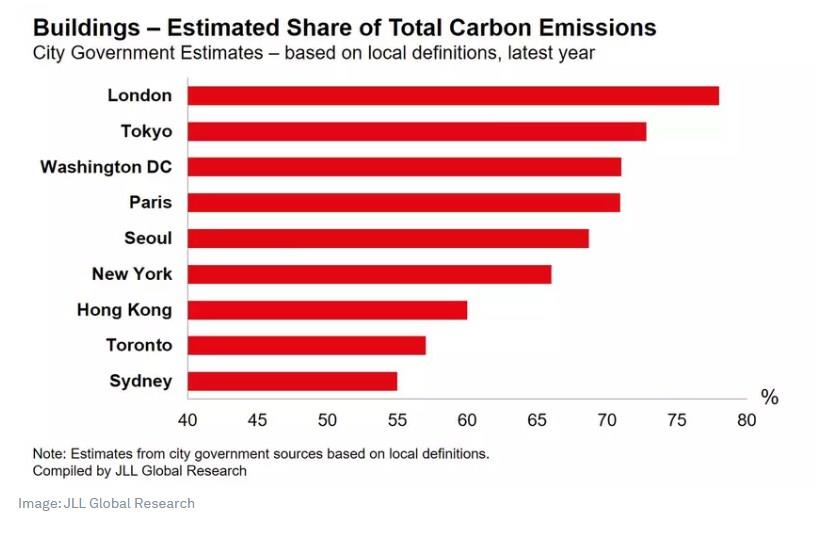by Christian Ulbrich*
In an increasingly challenging and volatile world, the urgent need to decarbonize real estate remains a constant.
There are no quick fixes that will suddenly transform today’s energy inefficient buildings into models of sustainable construction in the coming decades. It will take time, investment and expertise to retrofit the majority of buildings across urban areas.
Yet given that more than 60% of carbon emissions within cities typically come from buildings, a concerted effort is needed sooner rather than later.
It’s why longer-term commitments for a net-zero future are now fueling shorter-term pressures to start formulating action plans that will deliver steady progress.
Around the world, city governments are often leading the charge. From New York City to Paris to Singapore, many cities now have a raft of targets and actions covering new and existing commercial real estate.

While this momentum is to be applauded, it brings with it issues of its own.
JLL’s soon-to-be-published report “Decarbonizing Cities and Real Estate” reveals a rapidly evolving patchwork of regulations and metrics across 30 major global cities. With little harmonization or integration, it makes for a complex global picture.
Each city is drawing on a unique blend of tools to decarbonize buildings – from building codes, reporting and disclosure frameworks and energy audits, to minimum building standards, incentives and accelerators.
As a result, cross-border real estate investors and end-users are struggling to navigate the global net zero carbon (NZC) regulatory landscape to ensure their portfolios are future-proofed.
Cities to watch
Some cities are clear frontrunners in envisaging and implementing innovative plans. The familiar roll call of trailblazing “sustainable cities”, such as Copenhagen (with its Energy Leap initiative) and Vancouver (with its Zero Emissions Building Plan) are ahead once again. They have built up considerable momentum, experience and knowledge, and are hitting the ground running in this important decade of action.
But arguably, the ones to watch are the climate-progressive global gateway cities which are being most strident in their approach to decarbonizing buildings. In Asia, for example, Singapore’s Green Building Masterplan is an ambitious, target-focused roadmap to green its building stock by 2030. Tokyo’s cap-and-trade programme incentivizes building owners to reduce emissions by setting targets and allows parties to sell or purchase credits.
Over in the US, New York City has introduced a wide range of laws covering energy benchmarking, energy audits, emissions standards and building codes. It has also set one of the highest carbon taxes at $263 per ton of CO2.
And in Europe, Paris is taking a lead in tackling embodied carbon, with its “Design for Reuse Principles” and its RE2020 regulation which embraces entire life cycle carbon impact. London is setting the pace on biodiversity legislation, with requirements for major developments to create a ‘biodiversity net gain’ plan.
Collaborative models for the future
As best practice emerges in the trailblazing and climate-progressive cities, we’re reaching an inflection point where governments and the real estate industry need to work together on greater harmonization and consistency of policy, regulation and reporting.
We need to scale best practice globally. Many cities are only just starting on their decarbonization journey and can learn much from the successes, and the mistakes, of the leading cities. But far too often, they’re going down their own unique route.
Partnerships at all levels will be crucial to pool resource and knowledge, to share best practice, to educate and accelerate, to help scale technology, and to create the right balance between regulation, incentivization, coercion and advocacy. As decarbonization ramps up, we must bring with us the long tail of smaller landlords, investors and occupiers who often lack the knowledge and resource to take action independently.
City governments have a key role to play in creating the infrastructure, frameworks, laws and incentives for all stakeholders to be successful. In particular, they need to drive the greening of local energy grids, over which the real estate industry has little direct control.
And while decarbonization is the end goal, it must be pursued in tandem with social equity, affordability, biodiversity and climate adaptation.
If there’s one common thread currently linking all city governments, it’s the understanding that it’s time for urgent action. While the global regulatory landscape is confusing, as last year’s COP26 highlighted, there’s a wide recognition that emissions from buildings matter and there is strong appetite to build consistency across regulations, reporting and measurement standards.
Net-zero targets will simply not be achievable without a proactive and collaborative programme to significantly reduce embodied and operational carbon emissions from buildings.
By working together, learning from other cities, and sharing best practice, city governments will be better able to bridge the gap between intent and action and make this vital decade count a true tipping point in creating a more sustainable future.
*Global Chief Executive Officer; President, JLL
**first published in: www.weforum.org




 By: N. Peter Kramer
By: N. Peter Kramer

